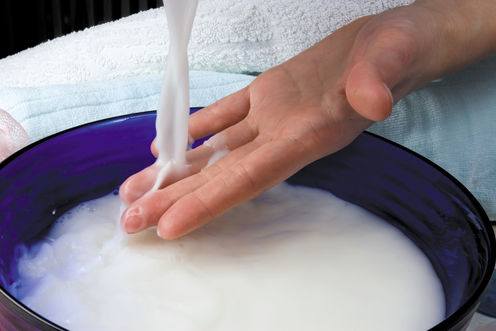
The death this week of a Victorian toddler after allegedly drinking “bath milk” is a reminder of how dangerous some natural cosmetics can be. The product – Mountain View Organic Dairy’s Organic Bath Milk – was recalled today.
“Bath milk” is raw cow’s milk. It is illegal to sell raw milk for human consumption in Australia so raw milk is sold as a cosmetic, labelled “not for human consumption”. While some believe this is a ruse to get around food safety laws, this could be immediately addressed as a cosmetic safety issue.
Under Australian consumer law, products are meant to be safe for consumers. Yet cosmetics accounted for 30% of injury reports to the Australian Competition and Consumer Commission (ACCC) in the past year.
Bath milk is particularly risky because it may contain the deadly shiga toxin-producing Escherichia coli (STEC E. coli) bacteria that can cause haemolytic uraemic syndrome. This is a particularly dangerous disease in young children that can cause kidney failure and strokes. STEC E. coli is the bug responsible for the fatal outbreak in South Australia in 1995 which originated from processed meat.
A child accidentally swallowing just a mouthful of bath water conditioned with bath milk could ingest enough bacteria to suffer serious illness. While this bath milk is labelled not for human consumption, children inevitably drink and squirt bath water from their mouth as part of normal bath play (and some of them can’t read warning labels). So this cosmetic needs to be of the highest microbiological safety.
Fortunately the ACCC has been investigating the role of microbiological contamination in cosmetic injuries, which has resulted in recalls in some instances. ACCC Deputy Chair Delia Rickard recently noted that cosmetic surveys revealing microbiological contamination were:
a timely reminder as the trend to produce all natural and all organic products may increase pressure on manufacturers to produce cosmetics with less preservatives or less effective natural preservatives.

Complicating this issue is that bath milk is often sold in containers that look just like drinking milk containers and may be stored in refrigerators alongside drinking milk. This may provide a false sense of security leading people to believe it is a food or as safe as a food.
We could learn from the European Union’s Cosmetic Regulation No 1223/2009 which states the:
presentation of a cosmetic product and in particular its form, odour, colour, appearance, packaging, labelling, volume or size should not endanger health and safety of consumers due to confusion with foodstuffs.
It is not surprising that consumers would confuse bath milk for a foodstuff, as even a cursory review of bath milk manufacturers’ websites suggest that even they confuse it for a foodstuff.
The European Union’s Cosmetic Regulation No 1223/2009 requires cosmetic manufacturers to produce a product that is not conducive to microbiological growth and defines the antimicrobial preservatives that might be used to prevent bacterial growth. However, the use of preservatives could be a problem in bath milk, as some of them could be dangerous if accidentally ingested.
The bath milk supplier at the centre of this incident reports getting regular tests that find the milk negative for bacteria. This highlights the need for good manufacturing practices and hazard-control interventions as even daily or weekly microbiological testing cannot ensure safety of a potentially hazardous product. End-product testing without a valid microbiological kill step is a hit-and-miss approach to product safety.
The media coverage of the risks of bath milk will hopefully lead to increased reporting of illness incidents to the ACCC leading to greater oversight of the industry. While bath milk suppliers may be reluctant to report illnesses to the ACCC, they risk a fine of up to A$16,650 for failing to comply with the mandatory reporting of serious consumer injury complaints (within two days) to the ACCC.
The history of food-borne disease associated with drinking raw milk will not be lost on the bath milk industry. Their best strategy may be to follow the lead of drinking milk manufacturers and find a method that will treat the product without taking away from its cosmetic qualities – pasteurisation, for example.
Craig Dalton has previously received state and federal funds for foodborne disease surveillance projects.
